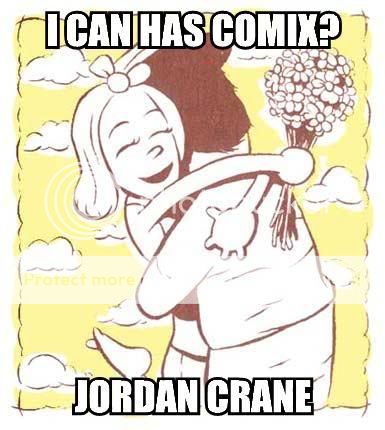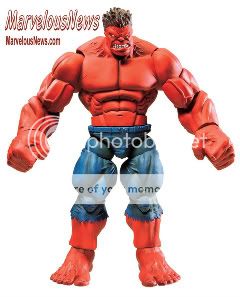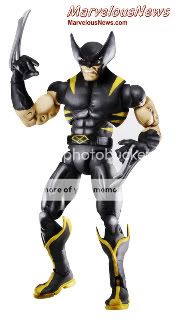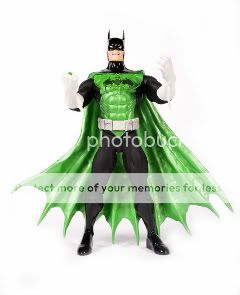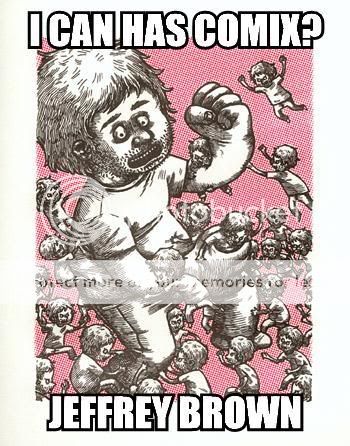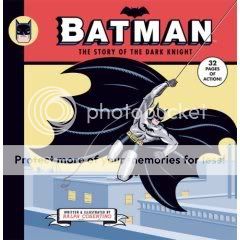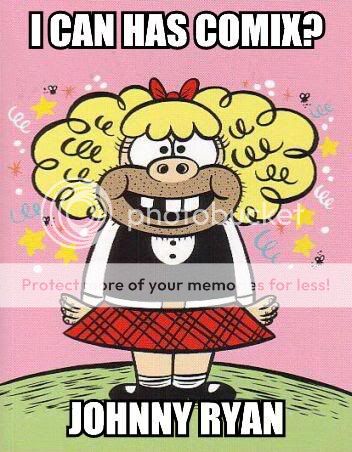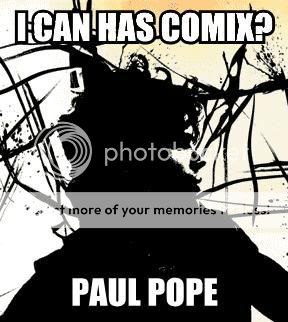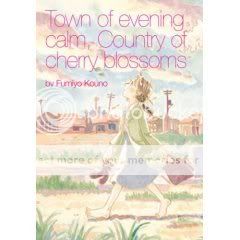[Editor’s note: This is one of a series of interviews I’ll be posting that were rescued from WizardUniverse.com’s now-defunct archives. Originally posted on August 31, 2007.]
I CAN HAS COMIX?: JORDAN CRANE
SUB: The writer-artist of the all-ages adventure ‘The Clouds Above’ and the grown-up series ‘Uptight’ on why he loves short stories, ghost stories and Geof Darrow–and why he hates animation, puns and ‘The Walking Dead’
By Sean T. Collins
If it weren’t for Jordan Crane, I wouldn’t be here.
At the same time as Grant Morrison and Frank Quitely’s New X-Men reignited my love affair with superheroes, an impulse purchase of Crane’s gorgeous, wistful graphic novella The Last Lonely Saturday was my ticket to a world beyond the spandex set. From there it was a short trip to Crane’s meticulously designed anthology series NON, a clearinghouse for undiscovered or underappreciated indie talents like Nick Bertozzi, Brian Ralph, Paul Pope and Ron Rege Jr.–starting a journey that deepened my love for the sequential art medium, changed my career trajectory and landed me here at Wizard.
So it’s no exaggeration to say that Crane’s work literally changed my life, even while it rapidly changed in and of itself. Crane has careened from whimsical children’s projects like The Clouds Above—Wizard‘s Best All-Ages Comic of 2006–to brutal ghost stories like his Western short story “The Hand of Gold” to lending his talented design hand to Fantagraphics’ anthology series Mome. His current focus is Uptight, a one-man pamphlet-format comic he’d like to see last as long as Love and Rockets.
Crane peeled himself away from his pet project to reveal his animation-industry origin story, tout the value of making beautiful things on the cheap, explain why winning the prestigious Xeric Grant hurt more than helped, and explore the one thing all comics must do (aside from changing lives, of course).
WIZARD: How did you get interested in comics?
CRANE: I read lots of comics as a kid and as a teenager. I think that’s pretty standard. I swore them off a number of times, trying to be an adult, then always went back to them. At first it was kind of like exploring, like, “Oh, what’s this? What’s that?” Then I started looking for things that personally resonated with me and got into more non-mainstream stuff. The first thing that really clicked for me was when I got the first couple of issues of [Steve Purcell’s] Sam & Max. I was like, “What the f— is this?” I loved how cartoony it was. Then I found [Marc Hansen’s] Ralph Snart, which is another weirdo comic, and [Dave Stevens’] The Rocketeer. That’s when I started going into the world of weirdo comics. It was something that kind of just naturally evolved.
But in college I studied a lot of animation. I really wanted to go into animation because I thought that it would be really cool. I made a couple of short movies, then I went out into the real world and started showing the movies I had made to some people at different animation houses around town. I went to Film Roman, the people that do “The Simpsons,” and Nickelodeon, and Klasky-Csupo, and a guy at Film Roman was like, “Wow, look at this reel! You could really get a good job–in China.” I had no idea that no animation is done here; it’s all key frames. I had these dreams of getting hired by Nickelodeon–“All right, come up with awesome stories and you’ll animate them and we’re just this big animation-loving world”–when in fact you would be lucky if you got to key-frame someone else’s story, and then maybe, if you’re really good at that and outgoing and have the wherewithal to write stories on your own, then maybe 10 years later you can actually write the animation or select the key frames. I basically thought that the animators were also the people that made the stories. That’s how guileless I was. So going into the real world was like a big f—ing crap on my birthday cake when I realized that those two things didn’t go together like I thought they did.
That was when I turned back to comics, because I was like, “I can actually write and draw everything I want.” I had been doing animation for about 3 years, but I still drew comics and was the comics editor at the school newspaper, so I was still drawing comics every day. It was really terrible because I really liked gag strips, but at the same time I was going through a really big existentialism phase. So the strips were supposed to be funny but were extremely unfunny. They had a bunch of puns in them and were about ennui: Imagine Godard’s retarded brother doing really bad puns. Puns are like the lowest form of humor. But to do a story in animation it takes about a year, so I come back to comics thinking “I’m going to do comic stories now instead of 4-panel gags.” I thought that I could just sit down and write all this stuff out. Having a little more room, I could start to mess around with things. I wasn’t tied down with it having to be funny in 4 panels, so I could go for a different kind of funny and a different kind of setup, a more long-term or ongoing story that wasn’t necessarily funny, but stories that would build. And I could do a story fast because it would take only 4 months instead of a year. So that was pretty much it. As soon as I figured out that animation was bullsh–, it was comics all the way.
What came first? Was it your anthology comic, NON?
CRANE: Yeah, that was the very first time that I ever did long comics. I had made a couple of aborted attempts. There was one when I was 17 and I had tried to do a post-apocalyptic comic about all the coolest sh– ever. It had hovercrafts and hotrods, you name it. Then in college I tried to do some kind of pretentious poetry thing that didn’t work out either. Both of those were abortive attempts; NON was the first time that I finished an actual comic story. I made the decision to start publishing because at the time there was all this Internet money floating around; I was making a lot of money.
What were you doing?
CRANE: I was a designer. This was about ’96 or ’97, and the Web thing was starting to gain momentum and I was making good money, which was certainly enough to publish. So I started that and was able to get a really good boost and not have to worry about making my money back. I think I priced everything really cavalierly [laughs], because I could, and I thought that I should. Because my whole intention with publishing was to make work that people could read. And I think that it still remains that way. It was to get people to read it first and worry about making money later.
Even today, your series Uptight is comparatively inexpensive for that format. The few pamphlet-format alternative comic books that exist tend to be not as cheap.
CRANE: My intention with Uptight was slightly different. I really got sick of waiting for 2 or 3 years between books. It was also brought on by the fact that I had kids, and my working time, while they were young, was cut down for a couple of years. I was having trouble getting in as much work as I could, so it took a long time to get pages done. The Clouds Above took a long time to get out, and that’s what I was working on when they were babies. All I had done up to that point was books: I had The Last Lonely Saturday and Col-Dee and then Clouds Above, and I was working on Keeping Two, too. I was like, “God, I’ve been working this whole f—ing time and nothing’s come out.” Every time I would see people I’d be like, “Oh yeah, I’m working,” but I wanted to be around and be like, “Yeah, I’ve got a new thing–here it is.” And I was getting sick of doing webcomics, because even though it was nice to have the deadline, I f—ing hate reading online. I just hate it. I don’t even like reading newspapers online. I do, but I only skim them at best.
And I also wanted to finish something, because when you’re working on books it’s every 4 or 5 years that you finish something; other than that you’re not finishing anything. The whole thing about finishing something is that you learn things, because you’re able to look back at it and go, “Well, that didn’t work” or “I should have been more adventurous with that part” or “I should have put more thought into that.” You’re able to look at it and see how you’re telling a story and see how your drawing or lettering worked and see how everything fit together, because it’s done and it’s a whole thing. I was only getting that every so often and I just didn’t feel as if I was growing at all; if I was, it was just glacially. So I really wanted to do short stories because I get to finish things. And I just really love the short-story form and reading short stories.
I think that actually ties back in to comic books. I really like comic books as opposed to graphic novels because it’s just a quick thing as opposed to sitting down and devoting yourself to something. The other thing is that if you don’t like it, it’s over. You can get a taste for something and know if you’re going to like it or not. If you do, you can get a nice little taste and you don’t need to have this giant meal all at once.
[For example,] I was just reading online about this comic book called The Walking Dead, and I was like, “F—, man, it’s a comic book about zombies and it’s called The Walking Dead. How could this be anything but f—ing awesome?” Then I go to the store and it’s on issue #40, and I’m like, “Wow. Well, maybe I should start at the beginning.” And of course they don’t have single issues and I have to buy a $10 graphic novel. Then I get home and read it and I’m like, “F— this!” and I just threw it into the trash. So there’s 10 bucks gone for this totally hackneyed comic book. It’s just so bad, formulaic and dull. I was disappointed just because it was called Walking Dead and that’s a great title, and I just didn’t understand how it could be bad. But if it was just a single issue I wouldn’t have been so pissed off because I’d just be like, “Ahh, you know, it’s not my thing.” With just 30 pages and 4 bucks I’m not going to be super-bummed-out about it.
The short form is nice. I just really like the short, quick thing. And maybe that’s just a function of my life right now, because I don’t have tons of time to devote to any one specific thing. But I wanted to do a comic so that I would have something that would come out regularly. I wanted a regular deadline, something that I could keep pace by. If I wanted those things, I figured the most important thing would be that I get to do those things. So I’m printing it as cheaply as possible until the numbers get up and it can support itself, so Fantagraphics doesn’t go, “You know, we can’t afford to give you your own vanity project.” I want to do it so that they can afford to do it and it not be a money-losing situation for them. I’d love to make it fancier, but that’s going to require numbers–and maybe I won’t even do it once I get numbers because I do like how simple it is. It’s almost like a minicomic. It will be nice to have the option of doing something different, like a full-color pullout, if I have the numbers there, but I don’t know. Maybe I won’t even do that. It might be nice to just have it be profitable instead of breaking even. But the most important thing is to just be able to do it. The book is really where you can go all fancy, whereas this is straightforward, read-it-here, no frills.
But it’s not as though you’re a stranger to frills. Take the very elaborate NON #5, for example–it’s a die-cut cardboard container holding three separate graphic novels wrapped within a hand-silkscreened cover. Why is design so important to your work?
CRANE: NON #5 is definitely a little different than all the rest of them. NON #5 took that shape because it had to. That was the only way to collect it all together. I was originally going to have Col-Dee and [Kurt Wolfgang’s graphic novella] Where Hats Go in the [main NON] book. That was the original plan. But then Kurt and I got Xeric Grants to print them and we were able to overlap projects, which theoretically would save me money. It would’ve been a hell of a lot cheaper just to print the book as one big book, now that I look back on the whole thing. Those Xeric Grants were actually a hindrance. I was like, “Thanks for the $8,000 that ended up costing me $5,000.” [Laughs] Since those were Xeric Grant books, I wanted them to be a part of the package, but they had to work separately because they were going to be sold separately as well.
So that was my solution to that problem: I looked at the budget constraints of the book and tried to figure out how to make it as cheaply as possible. “How can we make it and still turn a profit?” It was just accepting the constraints and not being like, “I’m going to push my publisher to spend money that they don’t have.” In one way the form isn’t the point. In the biggest way the form isn’t the point. It’s about working within those constraints and creating the most high-quality work that is possible. It’s giving the proper attention to creating a book. That’s pretty much the problem that I’m trying to solve every time that I approach a book. I’m like, “How can I make this as nice as possible?” That’s one of the things that I love about old stuff: I don’t love the fact that it’s old necessarily, I love that there’s a doorknob that somebody looked at and said, “Okay, this is a handle that needs to be turned in order to open a door. How can I make this as nice as possible–as beautiful as possible?” Not just, “How can I make this functional?” If it’s in a public place, somebody is going to be touching that doorknob 1,000 times a day, and at least half of those people are going to look at it. It would be nice if when they looked at the doorknob, it lifted them rather than it just being there. I like making something that doesn’t have to be beautiful, beautiful. I appreciate it when other people do it, so I try to do it myself.
When I got into comics after graduating from college, NON was the first anthology I’d come across. But we’re now in a heavily anthologized era: Kramers Ergot, Mome, Drawn & Quarterly Showcase…
CRANE: I know. Now I don’t have to do NON anymore! It’s great! I love it! [Laughs] That’s why I was doing NON: There was all this great work and none of it was published, and I wanted to publish my own work and this other stuff too. It wasn’t that I necessarily set out to do an anthology, it was that I just wanted to put all this other stuff into this book that I’m paying to print. But now there are so many damn anthologies that there’s practically no one that isn’t getting printed. I’m glad that I’m not publishing an anthology right now. And in a way, NON was really easy. It was a bunch of very obvious choices, because all these great guys were not being published. I was like a kid in a candy store. It was not a hard anthology to edit. [Laughs]
You’ve told stories in a wide variety of contrasting tones. For example, The Last Lonely Saturday is about an elderly couple and how they’re reunited after death, and it’s an incredibly sweet and romantic all-ages tale. But in Uptight #2, your story “Take Me Home” takes almost the exact same idea and spins it into this brutally grim, EC-flavored morality play. How do you handle this aspect of storytelling?
CRANE: Whenever a story occurs to me, I just want to do it. I don’t have one particular type of story that I’m interested in doing. If a story is exciting to me, then I work on it; if that story gets finished, then I can put it out. I don’t really have a filter, because with comics you can do anything that you want! That’s the great thing about comics. Anything that strikes my fancy is what I follow until the fancy has been stricken to death [laughs], or it actually winds up going somewhere.
So with The Clouds Above, you didn’t sit down and decide to do a children’s book?
CRANE: No. I love children’s books. And it’s not a children’s book–I was trying to do a children’s book, and they’re f—ing hard. I like fantastical stories with kids and I wanted to do an adventure story. There was a certain mood that I wanted to create in the story. It wasn’t that I was thinking that I wanted to hit a certain age group. If anything, Clouds Above isn’t malicious and f—ed-up enough. It needs to be way more malicious–which would remove it from the age group that it’s about and make it practically unreadable for kids. But there are plenty of kids’ stories that are totally f–ed up, and kids read them. I just wanted to create something that struck a certain emotional tone. That’s how I tried to go about it.
Who are your artistic influences?
CRANE: I could trace influences, but I don’t really look at anybody to see how to draw so much as I really like the way something makes me feel. At the very beginning I really liked Geof Darrow. Some of the basic things about the way I wanted to draw are that I don’t want to do half-toning and I don’t want to do cross-hatching. I want a straightforward black or white line. But apparently, somewhere along the line, it’s become okay for me to do washes [laughs], which seems to be completely against anything that I initially wanted to do. But I just love the way it looks. So washes are okay, apparently. As far as the line art, it’s always been clean-line art. No cross-hatching–it’s either black or white, and trying to make an image out of black and white. So to that end Geof Darrow really hit on something that I wanted, and I looked to him for a while. Then his influence fell off after a while, as I was trying to do less lines and trying to hit the actual thing without a lot of wrinkles and junk. But there are people whose art I feel a certain kinship with. For example, I like what Hank Ketcham does with black and whites. It’s amazing. He does a lot of cross-hatching and I don’t want to do that, but the things that he does with spaces of black and white is insane. And José Munoz draws so messy but it all makes sense, and he doesn’t give a f— where he puts black. He’s crazy. He just throws it on the paper and it’s really exciting. There’s just such life to his drawings. It’s the same with Jaime Hernandez–there’s so much expressiveness and he just lays down the black. It’s crazy. And then there’s Hergé, who practically doesn’t lay down any black. He does, but it’s very selective and there’s a lot of life to these apparently simple drawings. They really bounce, and they have a lot of heft and roll to them.
I think that covers the spectrum. You can see why I feel a kinship to those people, because it feels like there are similar aims, at least drawing-wise. Those are people that I feel are doing the drawing right. I agree with some aspect of their drawings and it makes me excited to feel this kinship with it. And it’s not like that’s the only kind of artwork that I like. I love John Porcellino and Kevin Huizenga. Kevin is another one that I feel a kinship with because of the simplicity and cleanliness of the way he draws. And Sammy Harkham, who I share a studio with–there are definitely things that he does that I really like. It’s mainly cartoony stuff, like the way he draws a puff of smoke coming out of someone’s eye.
Is E.C. Segar an influence on you? I see him mainly in your character designs, I think.
CRANE: I’d love to say yes, but I don’t think that I could draw anything as crazy as Segar. I really like how crazy he gets, but I guess I haven’t looked at enough Segar to say that he’s somebody I really pore over. I love his work. Frank King as well: I haven’t read enough of him to cite him as an influence. I like a lot of the old-time cartooning where it’s very simple, and there are areas of black and white and it’s very clear, and the character design doesn’t overwhelm the pacing. It all reads along at the same pace. I guess I’m trying to get away from the super-detailed.
And when you ask about influences, I don’t cite anybody outside of comics because I think the art for comics is very different than the art for illustration. A finished panel for a comic is an incomplete thing because it’s attached to the thing before it and the thing after it. If it’s complete then you’re at a kind of a standstill, so it needs to be incomplete. It needs to be not a full statement, and it’s kind of a very hard thing to do. Jaime does it really well. If you isolate any one of his panels, they just don’t work on their own. There are a couple which are intended to be complete statements, but by and large they don’t work on their own. Even some that you’d think would work when you’re isolating them don’t work. I’m doing a screen print with him soon, and I was going through a lot of his comics and trying to isolate panels that I thought would be awesome prints, and it took a lot longer than I initially thought. You’d think that you could take anything from Jaime because it’s all brilliant and amazing, but it actually doesn’t work on its own. So that’s why I’m citing only cartoonists, because I think it’s a very different style of drawing.
You’re also not mentioning any animators.
CRANE: It’s true. I don’t like animation anymore. [Laughs] The love affair is over. I had a really big appreciation for the early Max Fleischer stuff, but it’s not like I want to draw like that. It definitely is something that did not have an influence on me.
What are you working on now?
CRANE: Uptight #3!
Is Uptight the plan for the foreseeable future?
CRANE: Yeah–for the rest of the future, as far as I can tell. I just want to do Uptight. I’m obviously going to collect them, but it’s a place for everything that I’m working on so that I can have something regular come out. Short stories are necessary because you want there to be a finished thing in it. But I can also catch all the incomplete sh– that I’m working on too, because comic books do that as well. That’s what DC and Marvel are all about, because all that they have are incomplete stories. I’m working on some stories for the next issue of that, and possibly some new Simon & Jack stories. And also the usual terrifying and f—ed-up ghost stories. I keep on doing ghost stories because I still haven’t read a good one, so I want to try and write a good ghost story.
I’m always happy when people whose work I enjoy come out with comics on a regular basis. I think that some cartoonists have benefited from working in the long form–like the impact that Craig Thompson’s Blankets had just from being this giant phone-book-sized graphic novel–but it’s fun to get short-form comics as a fan.
CRANE: I think the short form keeps you engaging. That’s the most important thing for a comic to do, to be engaging–for it to demand that as a reader you give something to it, and you give it. To do that, each part should be complete–not just each story, but each part, each page, each row of panels. It’s subdividable. I mean, being utterly leadenly serialized is bad too, but…If you look at a novel, it’s made up of paragraphs and sentences, but each one of those is complete. When I look back at something like Col-Dee, which I worked on in long form, I see that parts of it are incomplete–not by design, but just because I didn’t see it.
So from now on, I don’t care if I never learn anything more about drawing. [Laughs] I just care about writing, and being engaging as a writer. I mean, that’s your f—ing job. Whether you look at someone like Stephen King or someone supposedly “good” like Flannery O’Connor, both of them, aside from their numerous differences, are engaging. That’s the hardest thing to be, the most important thing to be. If you can be engaging, f—! [Laughs]

